Make those Fourth of July photos count! Some tips on “shooting” fireworks!
Every now and again you get one of those years where all the main, get-off-of-work holidays land on a weekend rather than a Wednesday. 2015 is one of those years! Christmas is on a Friday (meaning New Year’s Day is on a Friday), Halloween is on a Saturday, Labor Day falls on a Monday 😉 , and, as it turns out, the Fourth of July falls on a Saturday! Next Saturday to be exact!
This means fun, food, and DEET are quickly approaching all to be topped off with that most magical part of the Fourth celebration: Fireworks! And, while we enjoy watching the skies fill with dazzling pyrotechnics, many of us like to freeze-frame the action a little too. Last year, I wrote a blog with tips on how to capture great shots of fireworks displays. Now you say: “Patrick, don’t you typically link back to previous blogs when you reference them in new ones like that? Where’s my link to these wonderful tidbits of photographic knowhow?!” Well, don’t fret, for I am reposting them below for this year! With that you are in luck, for I am including not only a few more tidbits above last year, but also some images I captured during last year’s local Briggs and Stratton Fireworks Extravaganza.
Like last year, I will preface this by saying one does not simply whip out their camera, flick your thumb and capture shots like you see in magazines. It requires a bit of prep, but the good news is: Anyone can do it, including you! So, without further ado, lets get you ready for next Saturday!
First of all, there are two broad types of cameras people are accustomed to these days: Smartphone cameras and digital single lens reflex (DSLR) cameras. Each is going to be a little different in how they are used to capture the show. I will discuss those differences below, however, first, I will discuss items both will require to capture the best shot.
Good location: A good location is going to be a must when it comes to capturing images of fireworks. Remember most professional fireworks displays take up a lot of real estate in the sky. So you want to be sure you have plenty of room, not only in front of you, but to either side of your field of vision. Like I said, these are long exposures meaning buildings, trees, power lines, hills, etc. can (and will) show up in the image even if you cannot see them really well in real time, so be sure to stake out a good location where plenty of sky is visible.
Dark location: For reasons I’ll get to below, you also need to find a relatively dark location. Let’s say you have a great view of the sky, but, for some reason you are shooting over the top of a well-lit gas station or street. Since these photos will require a healthy intake of light, a bright, stationery object or moving traffic is not going to look good in the final shot. Even a dimly lit or incidentally lit object will be very visible in the final product. Now, if you positively cannot get such a vantage, you may zoom in past the stray light source. You might still get a bit of light pollution haze, but you will not have distracting street lights in full view.

Flash: No matter the type of camera you have, disable the flash! It is supposed to be dark and the fireworks will be bright. Unless you have really specific artsy goals (like trying to capture your best friend’s engagement proposal backlit with fireworks), the flash is not going to be necessary for this endeavor.
Tripod: No matter what kind of camera you are using, your hands are still likely to be very human. As such, you are unlikely going to be able to hold them steady for the several seconds necessary to capture a sharp, eye-catching shot of streaming fireworks. Also be sure to place it in a location where it will not be disturbed or have folks walking or standing in front of it.
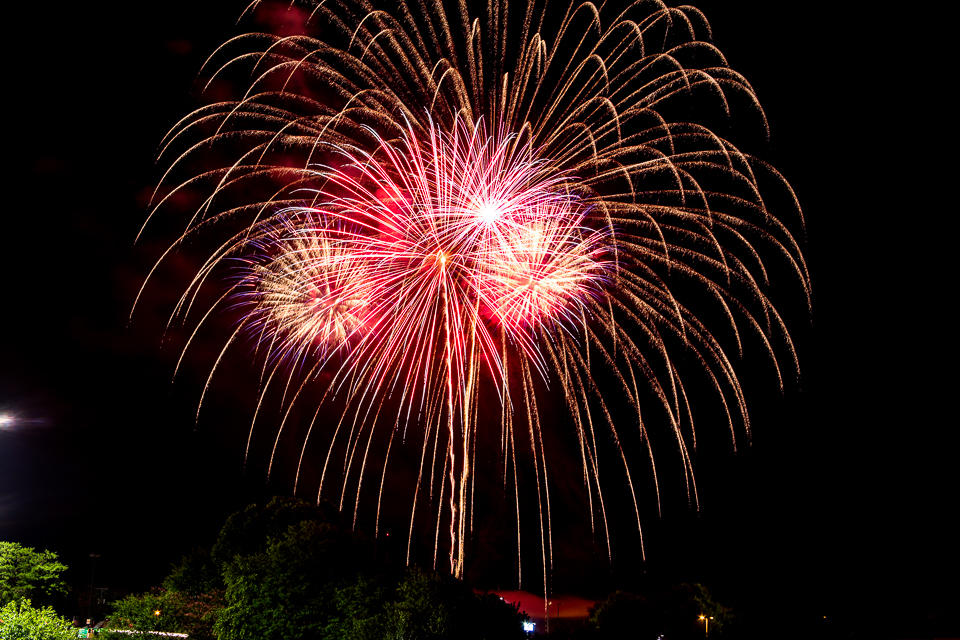
Camera Angle: Not all fireworks are created equal. Some explode high while others explode low placing them in different areas of your final shot. The best tip here is to try to average out your photo angle and not be moving your camera around too much. If you see one firework was captured too low in the shot, you might be tempted to tilt the lens downward only to be too low for the next high climber. In every show, there are many opportunities for shots and the best bet is to average your angle between the highs and lows, and let the rest be determined by delightful combination of calculated exposure lengths and simple chaos.
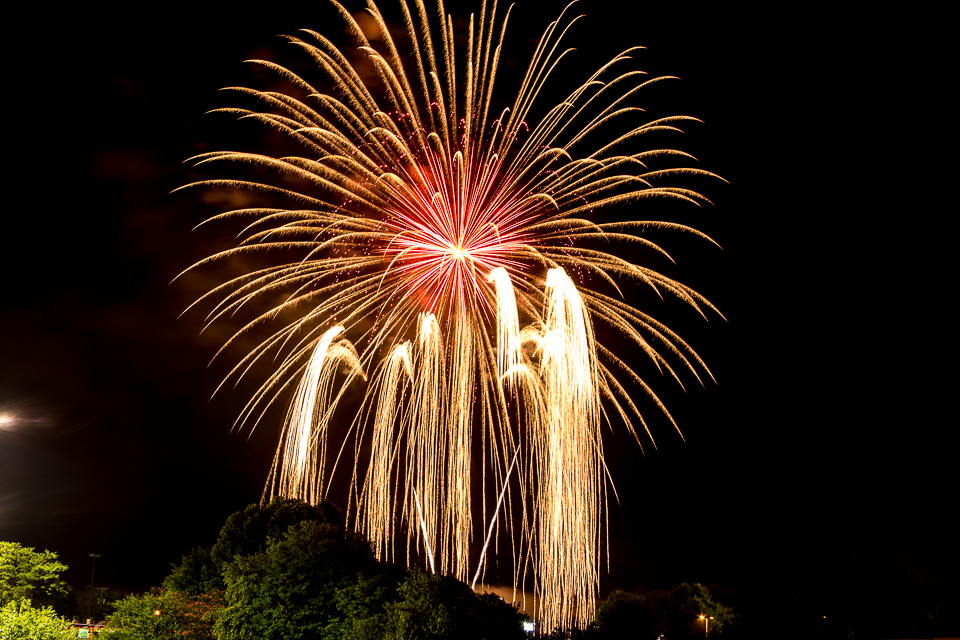
Camera Type: Now to the more specific animals: Your camera of choice! This will make a relatively significant difference in how you capture firework images so the type of camera you are using will require certain considerations. I’ll begin with the easy one!
Digital Single Lens Reflex (DSLR): These provide the most user-friendly settings for capturing some great fireworks display images, as it puts you in complete control of every function.
First of all, use a wide angle lens if possible. The sky is a big place and professional fireworks have a wide reach. You want to capture the whole bursts as often as possible and anything 50mm or higher might make this a little tricky.
Second is focus. As the fireworks will likely be quite a distance from you, focusing on the infinite horizon will be a good start. From there, just let the first few firework bursts be your guide to tweak your focus. The first few fireworks shot will not be the best ones, so consider them zero-hour warm-ups. I would use manual focus to do this, as auto focus in this kind of dark, fleeting-light scenario is just going to make you curse…a lot…in front of children!
Next comes aperture and ISO settings. Anything in the aperture range of f/5.6 to f/16 (I would go at least f/8 or f/11) will work at an ISO of at least 200 (but not too high, as higher ISO will result in more digital noise and stray light capture). This will allow a relatively sharp image with little interference from light reflections from ground. Just remember the larger the (f) value the smaller the amount of light is getting in, hence the sharper and more precise the fireworks stream.
Fourth is the shutter speed. Now, as I indicated above, these are fairly lengthy exposures. This is why you see those fireworks images and they are very streaky. Think of those points of pyrotechnic wonder as little paint brushes painting an image on a large black canvas. For this, I would recommend setting your camera to “bulb” mode, which holds the shutter open as long as the button is pressed. This allows you total control over when that shutter opens and closes (bearing in mind just one firework takes a few seconds to launch, burst, and trickle down).
With this, a shutter release cable is going to be your friend. This is either a wired or wireless remote that plugs into your camera, which will allow you to trigger the shutter without jostling the camera. It should also allow you to lock the shutter open preventing you from having to physically hold the button the whole time.
Smartphone: Now, comes the less user-friendly method: Smartphones. Bear in mind these cameras were not designed with a lot of tricky photography work in mind. However, as many rely on them as an alternative to higher end cameras, they might be many folks’ camera of choice this Independence Day.
Like with the DSLR, be sure to place it on a tripod, make sure its view is not obstructed, and give a wide angle zoom to your display.
Next, if possible, focus your scene (or set it to “infinity”) and turn off your auto focus feature. Smartphones are constantly searching for focus when it is aimed for a photo. This is not what you want when photographing fireworks, as it will likely drain your batteries and will not be focused on the right spot when the burst occurs.
Third, like with the DSLR, if you are able to adjust your ISO or aperture size on your phone, I would recommend similar settings to those listed above.
Lastly, you will need some kind of long exposure setting. Most, if not all, smartphones are not equipped with “bulb” mode, so the best option would be to download a “bulb” app. Now, I am not going to recommend apps I have not tried personally, however, if you have a favorite app download site, I would suggest conducting a search and some suitable apps should appear. Who knows, they might even have a “Fireworks” app out there to do all of this for you!
Technique tips: As for the actual aesthetics of capturing the brilliant fireworks displays, even for the pros, it can be a bit of an experiment. Thankfully, with digital cameras’ advantage of the instant view, it is not necessarily a costly one! Like I said above, they are not going to set off the best fireworks at first, so take a few seconds during the first few bursts to make tweaks to your focus, zoom, composition, and exposure settings.
Now, assuming you have all these nitty gritty, engineering details set, we can look more at the aesthetic (fun) side:
• Be sure to experiment with capturing a single firework as well as with capturing multiple fireworks in a single frame. Keep in mind, the longer you keep that shutter open, the more bursts you will record on a single frame.
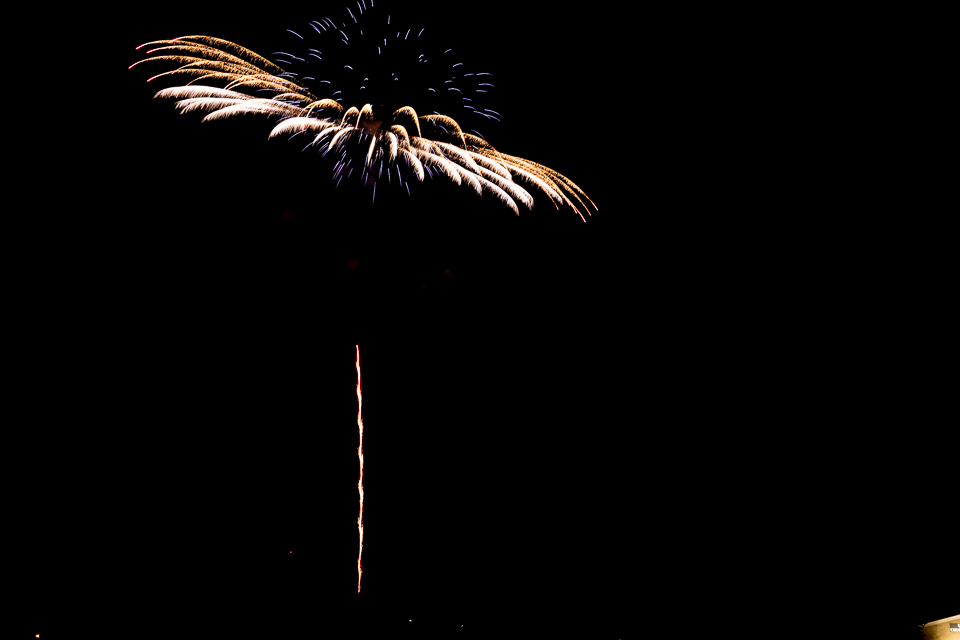

• At the same time, don’t proclaim your intentions of creating the “Best Fireworks Image Ever!” by capturing EVERY SINGLE FIREWORK in the show in one shot. In other words, don’t push the button when the first ball ascends and hold it until the finale has ended. This is going to end in a giant, busy, light cluster mess of an image that will not capture the majesty of the event. And it will let down all your fans who thought you were going to show them the “Best Fireworks Image Ever!”

• Now I know I said not to have a lot of obstructions from buildings and other opaque objects, however, you can experiment with various monuments, lakes, and people shadows if you want to be a little creative with your shot.
• Be sure not to leave your shutter open too terribly long. Not only do you not want an overly-busy cluster of bursts, but you also increase digital noise with excessive shutter times. The best thing is to open the shutter, and (imagine this) physically step out from behind the lens and allow the fireworks’ majestic light to directly hit your eyes for a moment! Keep a rough idea in your head as to what has been captured and open and close the shutter accordingly. Somewhere between 5 and 30-seconds (or one to four firework bursts at a time) should be adequate.
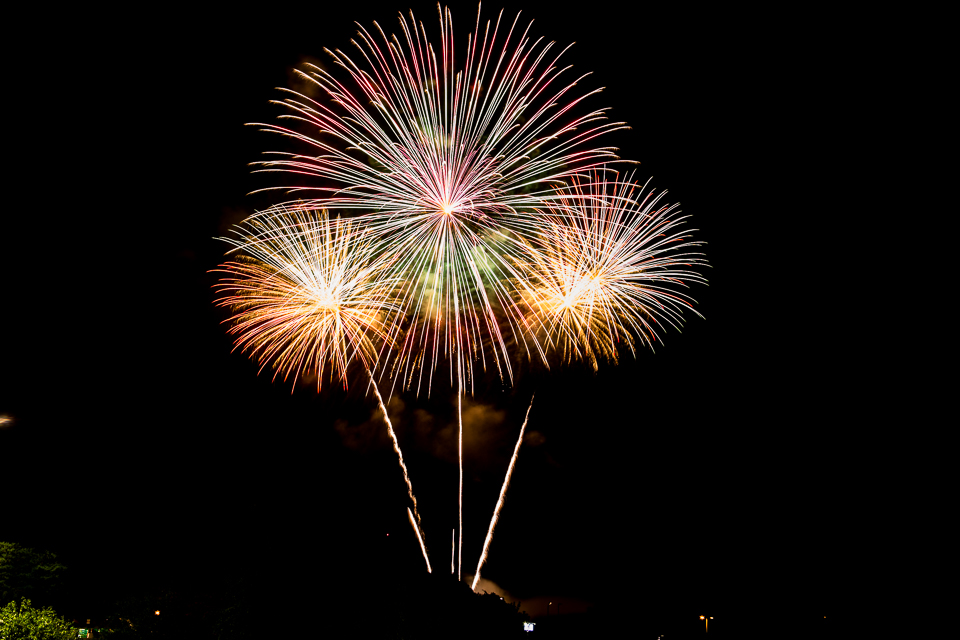
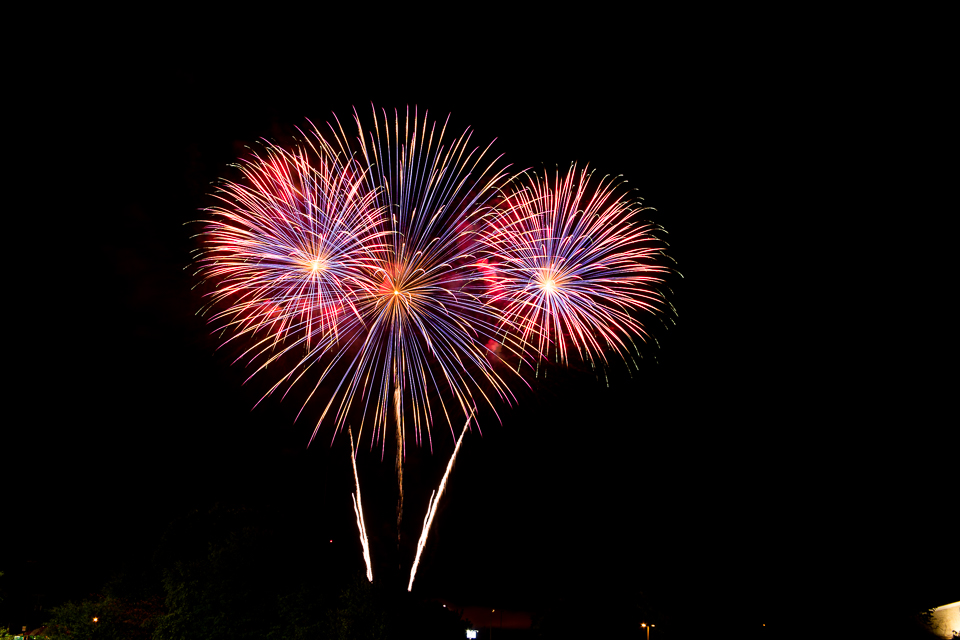

• Next, experiment with timing. Like I said above, the camera will capture every bit of light available to it when the shutter is open. This means it will also capture the firework’s ascent and any light bounces on lingering smoke. To help avoid this, keep with your timing. You can snap the shot as the burst occurs (omitting the ascension stream) and wait for smoke to clear before taking the next one (without wind, this might be difficult, so don’t get too bogged down on the smoke issue). Of course, Photoshop can help deal with either of these issues later, but these are simply ways to avoid it. (Also, if you want multiple bursts without ascension streams and without time-consuming photo editing, you might look into photo stacking in Photoshop, however that is a topic for a different blog).
For a few examples and other tips on fireworks photography, check this link out! (Fireworks Photography Tips)
For those who want to capture some memorable fireworks photos, hopefully this will set you on the right path and let you have some fun with your camera! In fact, if anyone reads these tips and has some great shots to show for their efforts, don’t be shy. Post them below in our comments section for all to see on Facebook!
Overall, just have fun. Remember, like every thing else, this kind of stuff takes practice and experience. Luckily for us shutterbugs, there is a great fireworks display every year on the Fourth of July!
With that, Abanathy Photography, LLC wishes everyone a fun and safe 4th of July weekend!